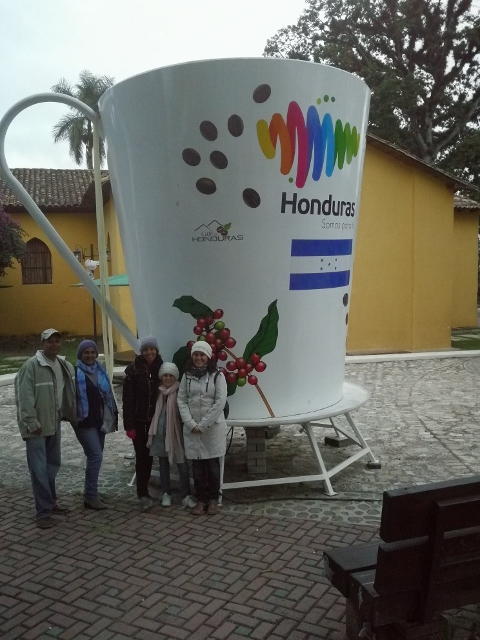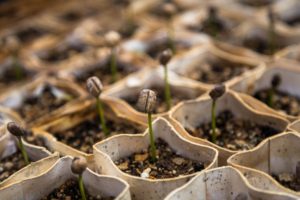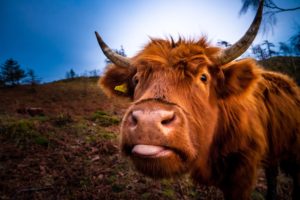I am sitting here with my cup of coffee, wondering, “How many cups of coffee is too much? How many did I have today? Where does the coffee come from? Where to find more good coffee?” And how can I ask for a coffee without milk in Spanish?
I love my coffee, early in the morning or late afternoon. But I like to find new, good coffee, and not always drink the same one. I enjoy brewing it in different manners too. So, I decided to start a coffee blog, to share some of my findings. I even made a fun fact about coffee article, which you can check out.

Where does the coffee come from?
In winter 2019/20 we came to Gracias, Lempira in Honduras for the first time. If you wonder where does the coffee come from, I can tell you right away that a lot of it comes from this area. As a signal to this, they built the world’s largest coffee cup. (It’s now, unfortunately, built an even bigger one, but that’s another history). And yes, we got served many good coffee cups here. However, coffee is grown around the world, I found good coffee from Vietnam too.
The world’s biggest coffee cup
For a few years, the world’s biggest cup of coffee (Yes, they filled it up) was here in Gracias, Lempira. But there is a lot of competition in these things, so now the world’s biggest coffee cup is in Colombia, at the park “Parque de Bolívar” in a city called Chinchiná. It takes 22,739.14 l or 6,007.04 US gal coffee to fill it up. Now, that’s one cup of coffee there.
Coffee is an important part of many people’s daily life. But how much do you know about where that cup of joe came from? Coffee beans are grown in tropical climates around the world, then roasted and ground into powder. The process takes anywhere from six months to three years.
The coffee comes from seeds that are inside berries, growing on a little coffee tree. They tend to like the climate up in the mountains, but they need their fair share of sun too. Who doesn’t? My dream is to one day plant my own little coffee bush that I can harvest.
Many locals around here do that. Then, in the months from December until March, they harvest or pick the seeds, and after a little process, they roast them and can drink it. This process includes drying the seeds, and now we call them beans. It’s a really fun time of the year. Many workers come to town. They fill up, I mean FILL UP, a pickup, mostly a Toyota HiLux in a more or less good condition, and head for the farm. This car then comes in return with an even bigger load of bags of coffee. Next, whatever open available space in the sun, is now a drying place for the coffee.
Learn about the origins of coffee.
Coffee is one of the oldest cultivated crops in the world. It was first discovered by the ancient Egyptians who used it as a ritual offering to the gods. They also used it to make wine and beer. In the 16th century, the Spanish introduced coffee to Europe. By the 18th century, coffee had become popular throughout Europe. Today, more than 80% of the world’s population drinks some form of coffee every day.
Understand how coffee beans grow.
Coffee beans are grown in tropical regions of Central America, South America, Africa, Asia, and Australia. Each region has its unique growing season and climate. The main difference between these regions is the altitude at which the coffee plants grow. This determines what type of bean will be produced.
Some good coffee-growing countries:
- Mid and South America
- Brazil, Colombia, Honduras, and Mexico (to mention some)
- Africa
- Ethiopia, Uganda, and Tanzania
- Asia
- Indonesia, Vietnam
Discover the different ways people use coffee.
There are several ways people consume coffee. You might drink it as an espresso shot, brewed into a cup of coffee, or added to milk or other beverages. It can also be used to flavor food or drinks.
Explore the history of coffee.
In ancient times, coffee was primarily grown in Ethiopia and Yemen. Today, coffee is produced in more than 80 countries. Coffee production has increased dramatically since the 1950s when coffee consumption began to rise in North America and Europe.
If you like to find out more about where does the coffee come from, like the history, I am making some articles about this too. Check them out. Here is the first part of the coffee history.
Here is a little coffee timeline table that shows some of the major events
This will help you to understand better “where does the coffee come from”.
| Year | Event | Place |
|---|---|---|
| 6th century CE | Kaldi, a goat herder, discovers the stimulating effects of coffee berries | Ethiopia |
| 1100 | The first coffee trees are cultivated on the Arabian Peninsula | Yemen |
| 1475 | The world’s first coffee shop, Kiva Han, opens | Constantinople (now Istanbul) |
| 1600 | Pope Clement VIII approves coffee as a Christian drink | Rome |
| 1616 | The Dutch smuggle a coffee plant out of Arabia and start cultivating it in their colonies | Java |
| 1652 | The first coffeehouse in Europe opens | London |
| 1670 | Coffee is introduced to the Americas by the French | Martinique |
| 1723 | Gabriel de Clieu brings a coffee plant to the Caribbean and starts a large-scale coffee production | Guadeloupe |
| 1730 | The British East India Company begins to import coffee from India | India |
| 1773 | The Boston Tea Party sparks a shift from tea to coffee among the American colonists | Boston |
| 1822 | The first espresso machine is invented by Louis Bernard Rabaut | France |
| 1865 | James Mason patents the first coffee percolator | USA |
| 1901 | Luigi Bezzera patents the first modern espresso machine | Italy |
| 1908 | Melitta Bentz invents the first paper coffee filter | Germany |
| 1933 | Dr. Ernest Illy develops the first automatic espresso machine | Italy |
| 1946 | Achille Gaggia invents the first espresso machine with a piston that creates crema | Italy |
| 1971 | Starbucks, the world’s largest coffee chain, is founded | Seattle |
| 1979 | The first specialty coffee roaster, Peet’s Coffee, is established | California |
| 1985 | The first World Barista Championship is held | Monte Carlo |
| 1991 | The first episode of Friends, a popular sitcom featuring a coffeehouse, airs | USA |
| 2006 | The first Coffee Review, a publication that rates and reviews coffees, is launched | USA |
| 2019 | The world consumes more than 2 billion cups of coffee per day | Worldwide |
And is this the future of coffee 2.0?
How many cups of coffee is too much?
-The answer to how many cups of coffee is too much must be one of the following:
- can you get too much good coffee?
- a number between having a headache from to little coffee -> the number before your head starts to hurt again
- Well, read under to find out. Just remember, I am no doctor. This is just based on brief research and you should not base your health on it.
Caffeine is a stimulant
Caffeine stimulates the central nervous system by increasing blood flow to the brain and body. This makes people feel more alert and awake. However, caffeine can cause side effects such as anxiety, insomnia, headaches, and stomach upset.
The effects of caffeine depend on the amount consumed
There are different amounts of caffeine in coffee, tea, soda, energy drinks, chocolate, and other foods and beverages. A cup of regular coffee contains 100 milligrams (mg) of caffeine, while an 8 oz. cup of brewed coffee has 200 mg. One 12 oz. cup of black coffee has 300 mg of caffeine.
There’s no safe level of caffeine consumption (and how many cups of coffee that is too much may differ)
There are different effects of caffeine on people based on age, gender, weight, and other factors. To sum it up, the answer to the question of how many cups of coffee is too much will vary from person to person.
While there isn’t an exact number of cups of coffee that will cause adverse reactions, experts recommend limiting yourself to no more than three cups per day. If you drink more than that, you might notice symptoms like headaches, anxiety, irritability, insomnia, and jitteriness
How to say coffee without milk in Spanish
Since we are in a Spanish-speaking country, and with other habits, we learned an important lesson. Here you might get a coffee sweetened with sugar and/or added milk, even without asking for it. Yes, I’ll have mine black, please.
So to say “coffee without milk” in Spanish, you can say: “Quiero un café sin leche, por favor”. Another way to put it, is to say how you prefer it. Then you can say “Prefiero mi café negro, sin leche y azúcar”.
Read more about good coffee
Good coffee is made by processing green beans into a beverage. Green coffee beans contain caffeine, chlorogenic acid, trigonelline, and other compounds. After the beans are processed, they are dried, roasted, ground, and brewed.


